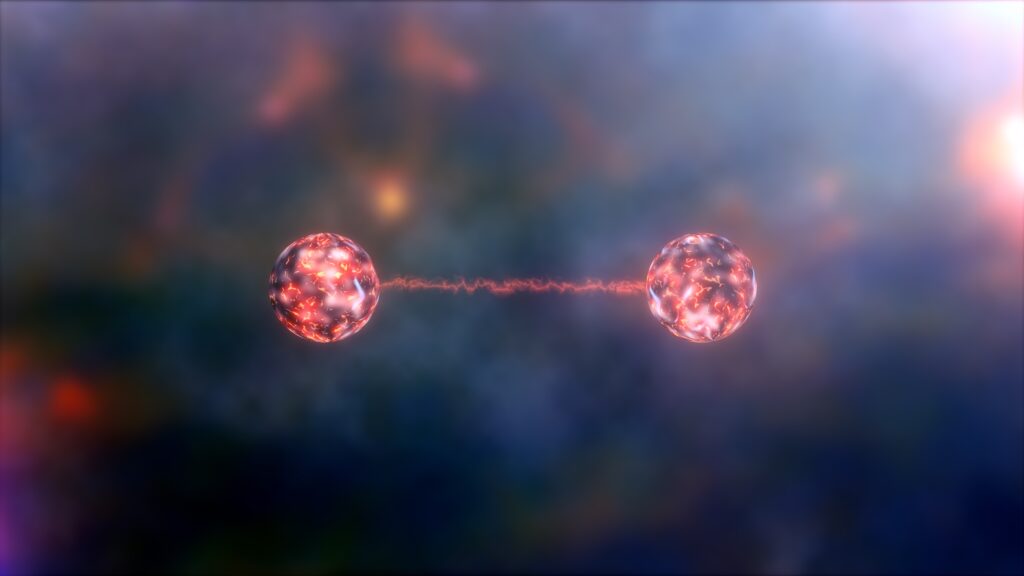Is Western thought marching towards Eastern Idealism?
Reading | Ontology
![]() Prof. Richard Grego, PhD | 2022-05-08
Prof. Richard Grego, PhD | 2022-05-08

Prof. Richard Grego argues that, if we extrapolate the evolutionary trajectory of Western scientific and philosophical thought since the European Enlightenment, it becomes possible to discern that it is progressing towards a consciousness-only ontology convergent with Eastern thought. This is a very scholarly but accessible essay.
Both Richard Richard Rorty [1] and Raymond Martin [2] have made the not altogether inaccurate, if somewhat simplistic, claim that ‘the mind’ (or consciousness), as we currently understand it in the West, is a contrivance of 17-18th century philosophy. Certainly, from the Enlightenment era onward, the predominant theories of mind and consciousness informing western philosophy, theology, psychology, cognitive science, neuroscience and popular culture have emerged from this intellectual legacy. As a consequence of the scientific revolution’s influence on what is often referred to as “the Western paradigm,” these theories have revolved around the “hard problem”: what is the mind-body relation and how can the existence of an immaterial mind be explained with respect to the material body? Since our minds and our conscious awareness, which seem to be non-material, also seem to involve the operations of our material body-brain, how does our nonmaterial mental experience relate to, or involve, the material world to which it is connected? Descartes’ “cogito ergo sum” first established the parameters of this problem by defining the respective ontological categories of ‘mind’ and ‘body,’ based on the “clear and distinct” datum of conscious experience that is plainly non-material, self-aware, subjective, purposeful and free, over against a physical body that is material, unaware, objective, purposeless and determined (except when it is animated by the mind that ‘inhabits’ it) [3]. This distinction also engendered further dichotomies like material/immaterial, subject/object, private /public, free/determined and natural/supernatural. As a founding father of the scientific revolution himself, Descartes understood that this division was an inevitable by-product of its naturalistic assumptions and methodology, which banished spirit, mind, meaning, purpose and value from the purview of physical science—and when adopted as a formal naturalistic metaphysics, would eventually banish them from reality entirely.
The mind-body / mental-physical “hard problem” [4] thus became, and continues to pose, a problematic dichotomy in the Western paradigm, and no field of knowledge or professional practice is unaffected by it. One consequence is that contemporary philosophy of mind has been configured by three general ‘umbrella’ theories of “dualism” (that mind and body are two distinct entities or elements of some sort [5]), “materialism” (that the physical world described by contemporary science is the only reality, and what we call mind-consciousness is merely the neurochemical activity of the brain, or some epiphenomenon of this activity)—probably still the most popular view in our science-dominated age [6]—and “idealism” (that what we call the physical world is actually an aspect of consciousness, which is the sole and fundamental reality [7]). A fourth option, sometimes referred to as “neutral monism” (that there is some indeterminate ultimate basis for all dimensions of reality—mental, physical and anything else—that encompasses all these without being reducible to any of them [8]) has also emerged at various times through the history of Western thought, but has until very recently received relatively little popular attention.
Again, given the paradigm-shaping prestige of science in Western intellectual culture, various materialist philosophies of mind continue to remain popular, perhaps dominant, in contemporary discourse. As science has become increasingly influential not only as a narrow method for pursuing certain limited kinds of problems and projects (methodological naturalism [9]), but also as a kind of grand theory describing the nature of all existence exhaustively (metaphysical naturalism or scientism[10]), mind-consciousness has consequently come to be regarded as a physical phenomenon or substance entirely describable via scientific categories. The once popular dualist view advocated by philosophers like Descartes gradually, through the 18th and 19th centuries, gave way to more materialist theories of mind, among which are theories like “identity theory” (that mental states are simply brain states[11]), “behaviorism” (that what we call mental states are, in fact, forms of physical behavior [12]) and “epiphenomenalism”(that mental states are an inconsequential residual by-product or ‘shadow’ of physical states [13]). This has culminated recently in a group of theories falling under the umbrella term “eliminativism,” which suggests that the very concept of consciousness should either be understood in terms of some behavioral or physical processes amenable to scientific quantification, or dismissed as a kind of brain-generated illusion [14].
Over the past few decades however, numerous logical and empirical critiques of materialism have gained increasing influence in philosophy of mind and consciousness studies, despite the persistent cultural prominence of scientism and materialist metaphysics. Cognitive and neuroscientists have noted, for instance, that despite years of research recording accurate correlations between mental states and physical-brain states, the physical sciences still lack any empirically viable theory regarding how these might be causally connected, and what mechanisms may be involved. Philosophers have pointed out how, contrary to claims by materialists that conscious experience is reducible to some physical entity or force describable by the physical sciences, consciousness remains nonetheless beyond the ability of the sciences to define, measure or describe in any coherent physical way. Thoughts, feelings, imagination, etc., have no discernable volume, mass, charge or any physically measurable property to qualify as physical entities verifiable by the scientific method. Nor is there any explanation for the more epiphenomenal materialist claim that consciousness is a byproduct of material processes, as there is no scientifically discernible or logically sensible way that something non-material (like mind) can magically pop out of the material world. The mind, it seems, is an undeniable aspect of reality that can’t be explained away via any quantifiable or empirical material explanation.
As a result of these problems, philosophy of mind in the West, since the late 20th century, has begun to produce an increasing number of theories that trend in the direction of idealism—even if most are unwilling to embrace it completely. Panpsychism, for instance, is another umbrella term for a group of popular recent theories that attempt to reconcile scientific materialism with consciousness as a fundamental reality. Panpsychism is the general thesis that mind-consciousness, while still ontologically distinct from the rest of the physical universe, is nonetheless integral to it, and a number of prominent formerly materialist neuroscientists and philosophers have expanded their metaphysical purviews to accommodate it. David Chalmers (who coined the term “hard problem”) [15], brain scientist Kristof Koch [16] and eminent philosopher Galen Strawson [17] are former materialists-turned-panpsychists. Phil Goff [18] and Itay Shani [19] have advocated a form of panpsychism known as cosmopsychism—in which consciousness is not only a fundamental element of material reality, but also foundational to it.
In addition to panpsychist theories that portray consciousness as coextensive with the material world, more specific physics-based theories portray mind as emergent from increasingly abstract conceptions of the material world. For example, Roger Penrose and Stuart Hameroff’s “orchestrated reduction” theory locates the origin of conscious awareness in state vector collapse of the Schrödinger wave function at the subatomic level, which takes place in the microtubules of the brain [20]. Giulio Tononi’s “integrated information theory” explains consciousness as the product of bits of quantum information functioning at high levels of complexity [21]. Bernard Carr traces consciousness to dimensions of hyperspace from contemporary string theory [22].
Beyond these, even more recent theories describe the status of consciousness in terms of straight-forward idealism. Bernardo Kastrup, for instance, conceives of consciousness as the single primordial substrate of all reality—encompassing completely the physical world described by science. Advocating a form of absolute idealism in the tradition of Schopenhauer (in a refined form that he calls “analytic idealism”) Kastrup conceives of material phenomena as kinds of mental qualities—resolving the “hard problem” by turning it on its head. Instead of attempting to explain how mind is possible in a material world, he explains how materiality, and the supposed separation between the mental and material, is all actually a form of conscious experience. Further, fundamental consciousness that creates the material world is a single substrate that only experiences material reality via individual minds, which in turn are dissociated aspects of this conscious substrate itself, like individual identities experienced by a person with multiple personality disorder. Material reality is a construct of the ultimate mind, and individuated minds experience this reality separately because they are estranged from their conscious source [23].
Interestingly, this trend in contemporary philosophy of mind suggests that the entire way in which Western metaphysics and mind are conceived may be evolving eventually toward some sort of self-transcendence, perhaps via a rapprochement with corresponding perennial ideas in Asian philosophical traditions. Several recent thinkers have drawn significant connections between Western cosmopsychism and idealism on one hand, and Hindu Advaita Vedanta philosophy (especially in its more recent neo-Vedanta formulations) on the other. Miri Albahari, for instance, has examined important similarities between Western cosmopsychism/idealism and Advaita Vedanta, while also noting substantial problems the former sometimes face and that the latter resolves. Western cosmopsychists (and even idealists like Kastrup to some extent), she claims, conceive of pure cosmic consciousness as a kind of ultimate or basic subject that posits the material world and other individual minds as its objects. However, in subtle contrast, Advaita Vedanta contends that the subjective and objective aspects of this reality are one and the same—both unified in the cosmic consciousness of which they are a part—just as the character’s perspective in a dream, and the seemingly external dream-world that this character perceives, are both ultimately aspects of a single unified consciousness that encompasses them both [24]. In Advaita Vedanta, rather than cosmic consciousness being a subject that posits each human mind –along with the apprehensions of each mind—as objects of its own apprehension, “nirvikulpa samadi” (the experience of Brahman or absolute Being, in its primordial state of unmitigated purity), like dreaming consciousness, is instead conscious experience prior to any subject/object duality, which also provides the basis for all the conscious subjects and their material objects of apprehension, generated as aspects of itself. Rather than a subject positing the world as its object, Brahman is the cosmic unity in which subject and object are unified. Advaita Vedanta’s cosmic consciousness is “one without a second” and beyond the subject/object relation that characterizes traditional Western conceptions of consciousness.
This kind of nuanced but significant difference that Albahari highlights between Advaita Vedanta and Western cosmopsychism/idealism can be illustrated further by contrasting Advaita Vedanta’s metaphysical categories with those of cosmopsychicism and idealism. Via its various interlocuters from Gaudapada and Shankara to modern neo-Vedanta philosophy, Advaita Vedanta views reality on the respective levels of ‘maya’ (the illusion of material and cognitive reality as the entirety of reality itself), “salvikalpa samadi” (the knowledge that one’s perception of cognitive-material reality is an illusional or truncated representation of true reality—Brahman), and “nirvikalpa samadi” (the experience of Brahman via pure experience itself, which transcends all knowing, even while encompassing it), which is nothing less than the vital experience of oneness with cosmic consciousness as it continuously creates all existence. Similar Western schools of thought all retain in some way a conception of consciousness (via various forms of subjective, absolute and analytic idealism, or panpsychism and cosmopsychism) shared by Advaita Vedanta, in recognizing the ultimately mental nature of both the cognitive/physical world and the cosmic consciousness generating it. However, the persistent understanding of consciousness in these Western conceptualizations always retains some sense of consciousness inhering in a substrate—whether this be the physical universe, as in many forms of panpsychism and cosmopsychism, or even perhaps Kastrup’s idealism, which posits a subjective substrate (“that which is conscious”) underwriting the contents of consciousness as its objects—which fails to resolve the dilemma of subject-object dualism as completely as the all-encompassing Advaita Vedanta cosmic mind does1. From the Advaita Vedanta perspective, Western panpsychism and Idealism remain at the ontological level of savikulpa samadi, rather than nirvikalpa samadi.
Thus, the trajectory of Western philosophy of mind appears to be culminating in a Vedanta-inspired universal conception of consciousness that transcends dualism, materialism and even idealism as heretofore conceived. Philosopher of science Michael Silberstein, for instance, subscribes to a “neutral monist” cosmology (based on current developments in theoretical physics and a ‘block universe’ interpretation of quantum cosmology, to which he has also drawn parallels with Advaita Vedanta metaphysics), which posits a more primordial source of all reality that precedes and grounds what we call material and mental—a source that is best described as what philosopher William James called ‘pure experience,’ or what Silberstein thinks may be best described as a kind of “presence” in and through which mental and material, subject and object, operate in contingent relation to one another [25]. The experience of my subjective mind encountering an objective material world co-arise with one another and create one another whenever there is an asymmetry or dichotomy in the primordial ‘presence’ that engenders them (also understood as “dependent co-arising” or “dependent origination” in Buddhist philosophy). “As I awaken in the morning, the world appears to me, and this asymmetric dichotomy between my mind and the material world arises,” physicists Adam Frank and Marcelo Gleiser and Philosopher Evan Thompson write,
At a deeper level, we might ask how experience comes to have a subject-object structure in the first place. Scientists and philosophers often work with the image of an ‘inside’ mind or subject grasping an outside world or object. But philosophers from different cultural traditions have challenged this image. For example, the philosopher William James (whose notion of ‘pure experience’ influenced Husserl and Whitehead) wrote in 1905 about the ‘active sense of living which we all enjoy, before reflection that shatters our instinctive world for us.’ That active sense of living doesn’t have an inside-outside/subject-object structure; it’s subsequent reflection that imposes this structure on experience. More than a millennium ago, Vasubandhu, an Indian Buddhist philosopher of the 4th to 5th century CE, criticised the reification of phenomena into independent subjects versus independent objects. For Vasubandhu, the subject-object structure is a deep-seated, cognitive distortion of a causal network of phenomenal moments that are empty of an inner subject grasping an outer object. [26]
Ultimately though, perhaps this ‘neutral’ kind of ‘presence’ might, as Advaita Vedanta suggests, actually be a deeper kind of consciousness –“pure experience” in James’ terms or ‘pure awareness’ in Advaita Vedanta terms. Since cosmic consciousness or Brahman (like ‘presence’ for Silberstein), as the primordial groundless ground of all existence, remains beyond the subject-object distinction and is the source of all possibility while remaining itself both immanent in, but irreducible to, any comprehension itself, it certainly would seem to exhibit the qualities that Silberstein’s neutral monism prescribes. Silberstein’s work suggests that the problematic nature of the hard problem perhaps involves the realization, foundational to so many Eastern philosophies and religions, that the living experience of consciousness transcends any theory—physical or philosophical—about it. As the ground of possibility for all theories, cosmic consciousness is not reducible to any theory itself.
Preeminent neo-Vedanta, idealist and comparative philosopher of world religions, Sarvepalli Radhakrishnan, maintained that Advaita Vedanta’s concept of “nirguna Brahman” (Brahman as primordial consciousness encountered beyond all conceptual representations) provides the world’s oldest original, perennial and universal mode of encountering existence that simultaneously transcends and includes all world civilizations’ religious, philosophical, scientific and other conceptual frameworks [27]. In this way, universal consciousness lies beyond our ability to comprehend it via any rational, discursive or abstract ideation that we may use to represent it conceptually—always exceeding any representation of it, although it engenders and encompasses these representations. This explains the inability of dualist, materialist, and even most Western idealist theories of mind to ever fully countenance consciousness. So long as we try to reduce consciousness—which is cosmic presence or pure awareness—to any abstract theory that fits neatly into a conceptual scheme, we separate our understanding from the very phenomenon we are attempting to understand, and so the ‘hard problem’ of consciousness in Western philosophy and science will never go away. As the Vedas famously proclaim:
Who knows for certain, who shall here declare it?
Whence was it born, and whence came this creation?
The gods were born after this world’s creation:
Who can know from whence it has arisen?None knoweth whence creation has arisen.
And whether he has or has not produced it.
He who surveys it in the highest heaven,
He only knows, or haply he may know not. [28]
References
- https://www.goodreads.com/book/show/31947.Philosophy_and_the_Mirror_of_Nature
- https://cup.columbia.edu/book/the-rise-and-fall-of-soul-and-self/9780231137447
- http://eddiejackson.net/web_documents/Descartes%27%20Meditations%20on%20First%20Philosophy.pdf
- https://blog.ted.com/the-hard-problem-of-consciousness-david-chalmers-at-ted2014/
- https://www.youtube.com/watch?v=7bIS3oRb6ag
- https://www.youtube.com/watch?v=VrRJit82aus
- https://www.youtube.com/watch?v=97MwsoHF2ps
- https://www.youtube.com/watch?v=15tupQ7wOd4
- https://www.naturalism.org/worldview-naturalism/tenets-of-naturalism
- https://www.naturalism.org/worldview-naturalism/tenets-of-naturalism
- https://www.youtube.com/watch?v=VrRJit82aus
- https://www.youtube.com/watch?v=VrRJit82aus
- https://www.youtube.com/watch?v=VrRJit82aus
- https://www.youtube.com/watch?v=xrFqhOvNtWM
- https://blog.ted.com/the-hard-problem-of-consciousness-david-chalmers-at-ted2014/
- https://www.youtube.com/watch?v=jZJ1XBrJhDc
- https://www.youtube.com/watch?v=Pi-TOxtczQQ
- https://www.youtube.com/watch?v=15tupQ7wOd4
- https://www.frontiersin.org/articles/10.3389/fpsyg.2020.00371/full
- https://video.search.yahoo.com/search/video?fr=mcafee&ei=UTF-8&p=penrose+hameroff+quantum+consciousness&type=E211US105G0#id=1&vid=25fb1d59b8e73148b9ef1cb6967b9e00&action=click
- https://www.youtube.com/watch?v=jZJ1XBrJhDc
- https://www.essentiafoundation.org/seeing/making-space-and-time-for-matter-and-mind/
- https://mindmatters.ai/2020/08/bernardo-kastrup-argues-for-a-universal-mind-as-a-reasonable-idea/
- https://www.panpsychism.com/handbook-panpsychism.pdf#page=132
- https://www.amazon.com/Beyond-Dynamical-Universe-Unifying-Experienced/dp/0198807082, https://philpapers.org/rec/SILPNM
- https://aeon.co/essays/the-blind-spot-of-science-is-the-neglect-of-lived-experience
- http://www.cronksite.com/wp-content/uploads/2014/02/RadhakrishnanGC.pdf , https://mast.queensu.ca/~murty/Lecture-11.pdf
- http://www.hinduonline.co/DigitalLibrary/SmallBooks/FourVedasEng.pdf
Editor’s notes
1 Bernardo Kastrup does not endorse this interpretation or characterization of analytic idealism. Under the latter, all experiences—and, therefore, all seeming ‘objects’—are merely excitations of a universal field of subjectivity, just as ripples are excitations of water. As such, for the same reason that there is ultimately nothing to ripples but water, there is ultimately nothing to physical objects—and even seemingly individual subjects, such as you and me—but the field of subjectivity itself. The subject-object dualism is thus completely resolved under analytic idealism. Allusions to ‘substrates,’ under analytic idealism, are merely metaphorical, meant to aid understanding, but do not entail or imply the ultimate existence of anything but pure subjectivity.

Essentia Foundation communicates, in an accessible but rigorous manner, the latest results in science and philosophy that point to the mental nature of reality. We are committed to strict, academic-level curation of the material we publish.
Recently published
Reading
Essays
Seeing
Videos
Let us build the future of our culture together
Essentia Foundation is a registered non-profit committed to making its content as accessible as possible. Therefore, we depend on contributions from people like you to continue to do our work. There are many ways to contribute.















